
The glossy ibis is a water bird in the order Pelecaniformes and the ibis and spoonbill family Threskiornithidae. The scientific name derives from Ancient Greek plegados and Latin, falcis, both meaning "sickle" and referring to the distinctive shape of the bill.
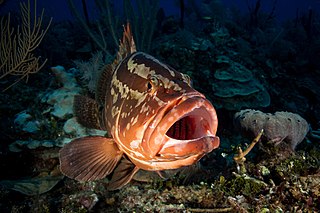
The Nassau grouper is one of the large number of perciform fishes in the family Serranidae commonly referred to as groupers. It is the most important of the groupers for commercial fishery in the West Indies, but has been endangered by overfishing.

The West Indian whistling duck is a whistling duck that breeds in the Caribbean. Alternative names are black-billed whistling duck and Cuban whistling duck.
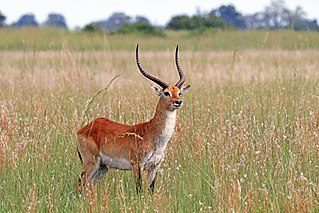
The lechwe, red lechwe, or southern lechwe is an antelope found in wetlands of south-central Africa.

The slaty-breasted rail is a rail species native to the Indian Subcontinent and Southeast Asia. Breeding has been recorded in July near Dehradun in the foothills of the Indian Himalayas. Despite traditionally being considered part of Gallirallus, recent genetic studies have consistently placed it in the genus Lewinia, which is now formally recognised by the IUCN and IOC.
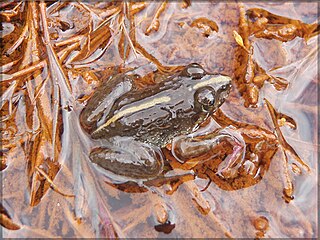
Minervarya greenii is a species of frog that is endemic to the hills of central Sri Lanka. It lives in wetland habitats within montane tropical moist forests. It is threatened by habitat loss, pollution, desiccation of wetlands, forest fires as well as predation by introduced rainbow trout.
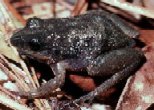
The southern chorus frog is a species of frog in the family Hylidae, endemic to the southeastern United States. Its natural habitats are temperate forests, temperate grassland, shrub-dominated wetlands, swamps, freshwater marshes, intermittent freshwater marshes, ponds, open excavations, seasonally flooded agricultural land, and canals and ditches. It is threatened by habitat loss.

The vitelline warbler is a songbird species in the New World warbler family (Parulidae). It is found in the Cayman Islands and on the Swan Islands in Honduras.

The red-legged thrush is a species of bird in the family Turdidae. Native to the Caribbean, it is found in the Bahamas, Cayman Islands, Cuba, Dominica, Hispaniola and Puerto Rico. It formerly occurred on the Swan Islands, Honduras, but was extirpated there.

The lesser jacana is a species of bird in the family Jacanidae. It is monotypic within the genus Microparra.

The Cuban fruit-eating bat is a species of bat in the family Phyllostomidae found in the Cayman Islands, Cuba, and Hispaniola .It has been extirpated from the Bahamas and Jamaica.
Cerion nanus is a species of medium-sized air-breathing land snail, a terrestrial pulmonate gastropod in the family Cerionidae.

Agalinis acuta is an annual hemiparasitic plant native to Maryland, Massachusetts, Rhode Island, Connecticut, and Long Island, New York. Common names include sandplain gerardia and sandplain false foxglove. It is one of about 70 species that comprise genus Agalinis. It currently resides within the family Orobanchaceae, but historically was aligned with members of the Scrophulariaceae. This was one of several re-alignments that were the consequence of the disintegration of the Scrophulariaceae as the result of conclusions based on molecular phylogeny data from the chloroplast genome. While historically regarded as a separate species, molecular phylogenetic data indicates that Agalinis acuta should be consolidated as part of the species Agalinis decemloba.

The wildlife of Pakistan comprises a diverse flora and fauna in a wide range of habitats from sea level to high elevation areas in the mountains, including 195 mammal, 668 bird species and more than 5000 species of Invertebrates. This diverse composition of the country's fauna is associated with its location in the transitional zone between two major zoogeographical regions, the Palearctic, and the Oriental. The northern regions of Pakistan, which include Khyber Pakhtunkhwa and Gilgit Baltistan include portions of two biodiversity hotspot, Mountains of Central Asia and Himalayas.
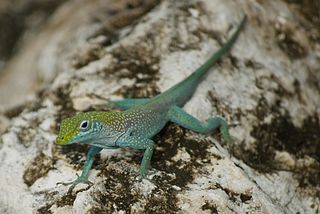
Anolis conspersus, also known as the Cayman Islands blue-fanned anole, Grand Cayman blue-fanned anole or Grand Cayman anole, is a species of anole found on the Cayman Islands.

Agave caymanensis is a species of agave that is endemic to Grand Cayman, Little Cayman and Cayman Brac in the Cayman Islands. It can be found in dry shrubland at all elevations of the islands. A. caymanensis gradually forms a short trunk, that is clothed in dead leaves. It can reach heights of 4 m and widths of 3 m with a rosette of massive, succulent leaves rimmed with thorns. It is monocarpic, and flowering is quite synchronous. Young rock iguanas sometimes use the hollow core of dead flower spikes as a refuge. This species was previously confused with A. sobolifera until described by Proctor as a separate species in 2012.
Argythamnia proctorii, the Cayman silverbush, is a species of silverbush that is endemic to the Cayman Islands. It is widespread in the forests of all three Cayman Islands, and its population is estimated to be 428,000 mature individuals. It is an erect, wiry-stemmed plant growing to about 1.5 m tall. It is monoecious, and seed capsules are produced year-round. When the seed capsules are ripe, they dry and explode, scattering the seeds.

Agalinis gattingeri, the roundstem false foxglove, is an annual hemiparasitic forb measuring between 10.5 and 60.5 cm in height.

The Cayman least gecko is a species of lizard in the family Sphaerodactylidae. It is endemic to Cayman Brac in the Cayman Islands.

















